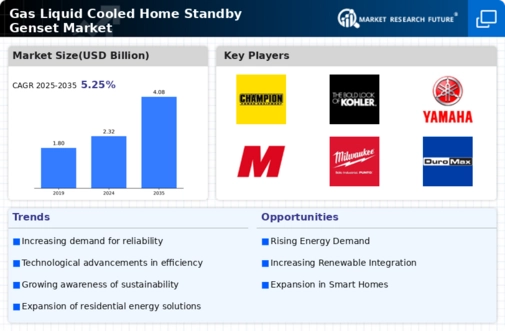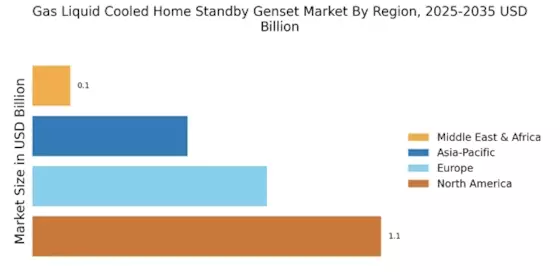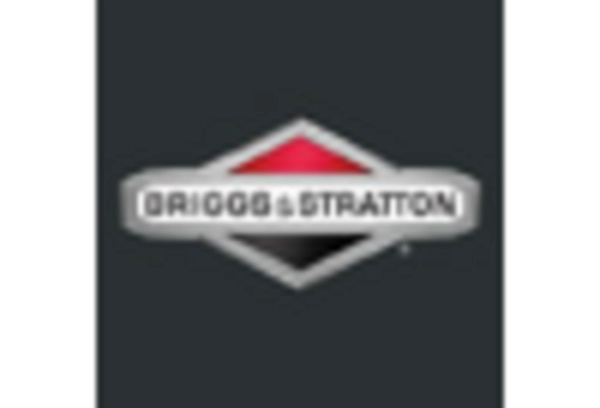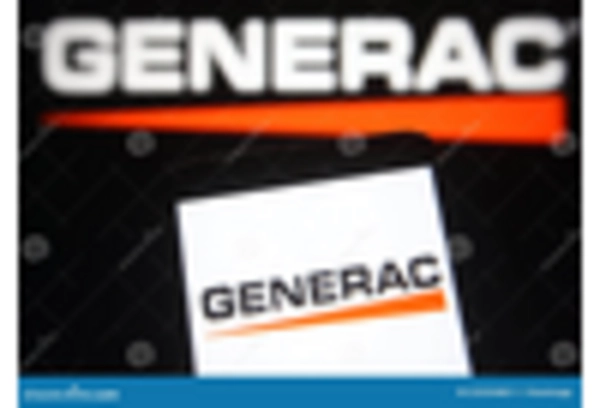Rising Energy Costs
The escalating costs of energy are driving consumers to seek alternative power solutions, thereby propelling the Gas Liquid Cooled Home Standby Genset Market. As electricity prices continue to rise, homeowners are increasingly investing in standby generators to mitigate the financial impact of outages. In recent years, energy prices have shown a consistent upward trend, with some regions experiencing increases of over 20%. This economic pressure encourages consumers to consider long-term investments in energy security, making gas liquid cooled gensets an attractive option. Furthermore, the potential for savings during peak demand periods enhances the appeal of these systems. As a result, the market for gas liquid cooled home standby gensets is likely to expand, driven by the need for reliable and cost-effective energy solutions.
Environmental Regulations
Stringent environmental regulations are influencing the Gas Liquid Cooled Home Standby Genset Market, as consumers and manufacturers alike strive to comply with new standards. Governments are increasingly implementing policies aimed at reducing emissions and promoting cleaner energy sources. This regulatory landscape encourages the development and adoption of gas liquid cooled gensets, which are often more environmentally friendly compared to traditional diesel generators. The market has seen a shift towards products that meet or exceed these regulations, with many manufacturers investing in research and development to enhance the efficiency and sustainability of their offerings. As a result, the demand for compliant gas liquid cooled home standby gensets is expected to rise, reflecting a broader commitment to environmental stewardship and sustainable energy practices.
Technological Innovations
Technological advancements are reshaping the Gas Liquid Cooled Home Standby Genset Market, leading to more efficient and user-friendly products. Innovations in engine design, fuel efficiency, and control systems are enhancing the performance of gas liquid cooled gensets. For instance, the integration of smart technology allows for remote monitoring and management, making these systems more appealing to tech-savvy consumers. Additionally, advancements in noise reduction and emissions control are addressing common consumer concerns, further driving adoption. As manufacturers continue to innovate, the market is likely to witness an influx of new products that cater to evolving consumer preferences, thereby expanding the overall market for gas liquid cooled home standby gensets.
Increased Frequency of Power Outages
The growing frequency of power outages due to extreme weather events and aging infrastructure is a significant driver for the Gas Liquid Cooled Home Standby Genset Market. Homeowners are increasingly aware of the risks associated with unreliable power supply, prompting them to invest in standby generators for peace of mind. Reports indicate that the number of outages has risen dramatically in certain regions, with some areas experiencing outages lasting several hours or even days. This trend highlights the necessity for reliable backup power solutions, positioning gas liquid cooled gensets as a viable option. The ability of these systems to provide uninterrupted power during critical times enhances their attractiveness to consumers, thereby stimulating market growth.
Growing Awareness of Energy Independence
The increasing awareness of energy independence is a pivotal factor influencing the Gas Liquid Cooled Home Standby Genset Market. Consumers are becoming more conscious of their reliance on centralized power grids and the vulnerabilities associated with them. This shift in mindset is prompting homeowners to seek alternative energy solutions that provide autonomy and reliability. Gas liquid cooled gensets offer a practical means to achieve energy independence, allowing users to generate their own power during outages or peak demand periods. As this trend continues to gain traction, the market for gas liquid cooled home standby gensets is expected to flourish, driven by a collective desire for self-sufficiency and resilience in energy consumption.


















Leave a Comment